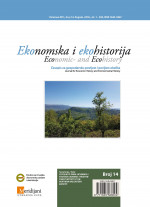THE WAKO’S ECONOMIC WARFARE AND THE MAKING OF THE EAST ASIAN SEAS’ ORDER
THE WAKO’S ECONOMIC WARFARE AND THE MAKING OF THE EAST ASIAN SEAS’ ORDER
Author(s): Isao KoshimuraSubject(s): Economy, Economic history, 16th Century
Published by: Društvo za hrvatsku ekonomsku povijest i ekohistoriju - Izdavačka kuća Meridijani
Keywords: Wako; Ming dynasty; silver use; Tributary system; «Horse Fair«; »Mutual Fair«; Portuguese/Spanish merchants; Jiajing Wako Raids; Estuary people; Wang Zhi Zheng; Chenggong (Koxinga);
Summary/Abstract: This article and the last article1 on »Uskoks’ War Economy« consider why Uskok and Wako piracy played an active part for almost the same period in the late sixteenth century. In the previous article, the author pointed out that the succession states of the Mongol Empire, assuming this world empire to be a common base, formed several empires including the Ming Empire. First, to understand the context in which Wako appeared, I will present three(macro, mesoscopic, micro) dimensions of the situation. 1.The macro (Eurasian) dimension. The Ming dynasty returned to trade with silver from the Mongol Empire, though this was always denied by the Ming dynasty. It coincided with the significant change of policy. In 1570, the leader of nomadic herders, Altan Qayan, would conclude peace and start trade with the Ming dynasty. This trade, called »Horse Fair,« was the new »shore« trade after the relaxation of the Sea Ban. 2.The mesoscopic (East Asian) dimension. Japan needed to develop its economy and resolve its financial difficulties through trade with China. On a political level, China wanted to retain the integrity of its great nation, and »economically its strength was not equal to its wish.« Historian Arano emphasized two factors in the process of change: »Wako« and »Portals.« As for »the Wako situation,« he pointed out that the last interchange between the areas of the China sea regions, especially traditional public trade, was seized by »the Wako power( the European power, the Japanese power, the Chinese marine merchants),« and therefore an international dispute did not die out in this area. 3. The micro (the East China Seas) dimension. Gakusho Nakajima offers new periodization of the history of the area, dividing it into five segments: ① Tribute, Ryukyu trade period, ② Shuangyu Wako period, ③ Wako, Western trade period, ④ Western trade period, ⑤ Western/ Chinese ship trade period. After 1570, various trade routes such as the tributary system, international trade with foreign merchants, and the Southeastern Asian trade conducted by the Chinese marine commerce were allowed. Second, the Historiographical Institute of Tokyo University Institute describes the Wako, especially the »Jiajing Wako Raids«: The friction between the government officials and various groups of smugglers, as well as the rivalry among these groups, formed the »substance« or prerequisite of Wako piracy. These frictions developed along the Jiangsu shores and then in Zhejiang (Fujian) when newcomers, including the Portuguese, entered the smuggling network of the Chinese along with the Japanese. I believe this to be the comprehensive definition since it was based on results gathered from the great amount of available Wako studies. I intend to present the trends in the Wako studies of China and Japan. In the Japanese historiography, significant new explanatory models moved further from the Marxist historiography, and they included the Wako phenomenon. There is a study on Wako members unprecedented elsewhere. I introduce several themes or groups, among them, »estuary people« who lived from fishing and water transportation seem to be important. They joined the Ming forces and were called to suppress Wako but eventually joined them. Third, we will first concretely detail the change of the trade that was discussed previously. Then we will inspect what kind of trade Wang Zhi, the leader of late Wako, expected, and confirm how the intense struggle over the Sea Ban policy in the form of the »Jiajing Wako Raids« ended. In the following, I introduce the latest study on Wang Zhi in detail. However, the author perceives that the attitude toward the authorities of Wang Zhi was ambiguous. On the other hand, the position toward the authorities of Zheng Chenggong was clear, and he built authorities by himself. Zheng Chenggong or Koxinga was in contrast to Wang Zhi at the point. Finally, Around 1570, the Ming dynasty changed its commerce policy while Portuguese/Spanish merchants reclaimed the new trade route at the same time. In this way, the trade order of East Asia was entirely reorganized. Nakajima names this new trade order simply the »1570 system.« And around 1570 the second phase of the »long sixteenth century« began.
Journal: Ekonomska i ekohistorija - Časopis za gospodarsku povijest i povijest okoliša
- Issue Year: 2018
- Issue No: 14
- Page Range: 225-249
- Page Count: 25
- Language: English

